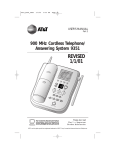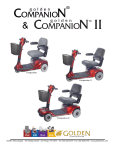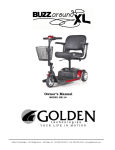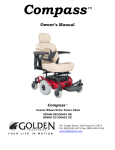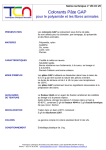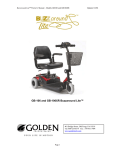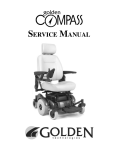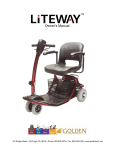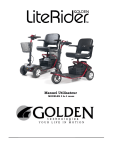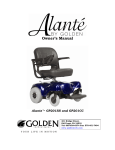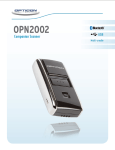Download Golden Technologies GC340 User's Manual
Transcript
Owner’s Manual Companion I Companion II, 3-wheel Companion II, 4-wheel Golden Technologies · 401 Bridge Street · Old Forge, PA · Tel: 800-624-6374 · Fax: 800-628-5165 · www.goldentech.com Thank you for purchasing your Companion Scooter. We are honored you have chosen Golden Technologies for your mobility needs. Please note, unless otherwise specified, the term Companion refers to each of the models listed below: Companion I — 3 wheel scooter GC240 — 300 lb. load capacity Companion II – 3 wheel scooters GC340 – 350 lb. load capacity Companion II – 4 wheel scooters GC440 – 350 lb. load capacity Standard Packing List: 1 Owner’s Manual 1 Consumer Instructional DVD 2 Battery Cables with Hardware 1 Front Basket 1 Seat with Arms 2 Keys Charger Seat Post Nut and Bolt DISCLAIMER We ask that you read this manual completely before operating your new Companion. Golden Technologies, Inc. is not and cannot be held responsible for any damage or injury incurred due to improper or unsafe use of the Golden Companion scooter. Golden Technologies, Inc. specifically disclaims responsibility for any bodily injury or property damage that may occur during any use that does not comply with applicable federal, state, or local laws or ordinances. Companion Owner's Manual: GC240, GC340, GC440 CONTENTS I. INTRODUCTION................................................................................................................... 4 Features and Benefits ................................................................................................................. 5 Accessories for the Companion Scooter...................................................................................... 6 II. SAFETY ............................................................................................................................... 7 III. EMI/RFI ............................................................................................................................ 11 IV. YOUR GOLDEN COMPANION ...................................................................................... 12 Specifications .......................................................................................................................... 13 V. OPERATION ..................................................................................................................... 14 Controls ................................................................................................................................... 14 Control Options ...................................................................................................................... 16 Seating Controls ...................................................................................................................... 16 Freewheel Mode....................................................................................................................... 18 VI. RIDING YOUR COMPANION ........................................................................................ 19 Mounting ................................................................................................................................. 19 Basic Driving ......................................................................................................................... 19 Steering in Tight Spots ............................................................................................................ 20 VII. DISASSEMBLY .............................................................................................................. 22 VIII. ASSEMBLY ................................................................................................................... 24 IX. TRANSPORTING YOUR COMPANION ........................................................................ 26 X. CARE AND MAINTENANCE .......................................................................................... 27 Routine Maintenance................................................................................................................ 27 Cleaning Your Companion ....................................................................................................... 27 Batteries and Charging ............................................................................................................. 28 If Your Companion Does Not Operate...................................................................................... 29 Diagnostics............................................................................................................................... 30 XI. WARRANTY .................................................................................................................... 33 Registration Card ..................................................................................................................... 35 Companion 3 Companion Owner's Manual: GC240, GC340, GC440 I. INTRODUCTION Congratulations on the purchase of your new Golden Companion scooter. The Companion, the Companion II, and the four-wheel Companion II all combine cutting edge technology with attractive designs that are also highly functional in today’s world. We at Golden Technologies, Inc. know that you have chosen a scooter that will give you years of dependable operation and also will enhance the quality of your life by providing you with the mobility to experience an active daily life-style. Even though your new Companion is both user-friendly and designed for maximum maneuverability in even the tightest spaces, we ask that you please read, understand and follow all of the instructions and suggestions in this manual before you operate your Companion for the first time. The safe use of your new scooter is very important to us. If you feel that you do not understand the instructions and suggestions presented in this owner’s manual, or if, for any reason, you do not feel capable of performing the activities necessary to assemble, disassemble, operate, or maintain your Companion, please contact your local Golden Technologies, Inc. representative or call Golden Technologies, Inc. Technical Support Services at (800) 624-6374. Golden Technologies, Inc. cannot be held responsible for personal injury or property damage resulting from the unsafe or the improper use of any of our broad range of health and personal mobility products. Also, Golden Technologies, Inc. cannot be held responsible for personal injury or property damage resulting from attempts to follow instructions, suggestions, and guidelines presented in this owner’s manual. Our Research and Development Department, our Quality Control Department, and our Engineering Department have used the latest product specifications and the latest product design information to produce this owner’s manual. Golden Technologies, Inc. reserves the right to implement changes into our product lines when those changes become desirable or necessary. If changes are implemented into our product line, there may be minor differences between the product you purchased and the illustrations and instructions in this owner’s manual. Please fill out and mail the enclosed warranty registration card. We at Golden Technologies, Inc. would appreciate hearing about the dependability of your Companion and about the convenience of mobility it has provided for you. We would also appreciate hearing about the service you received from your local Golden Technologies, Inc. dealer or representative. Golden Technologies, Inc. 401 Bridge Street Old Forge, PA 18518 Phone: (570) 451-7477 Fax: (570) 451-7494 Toll free: (800) 624-6374 For more information about our products and services or to send us your comments, please visit our website at www.goldentech.com Companion 4 Companion Owner's Manual: GC240, GC340, GC440 I. INTRODUCTION Features and Benefits Your Golden Companion scooter shipping carton contains an informational DVD that highlights the features and benefits of your Companion scooter as well as important safety and operating instructions. Please view this video and read the Owner's Manual in its entirety for complete safety and operating instructions. Control Panel: Easy to read display features backlit battery gauge; two horn buttons; the key switch; and the red button that turns the headlight and taillights on and off. Delta Tiller handle: Offers cushioned hand rests for comfort and dual throttle control levers for easy right or left hand use. Off-board charger: The charger port is located conveniently on the tiller behind a protective cover. Slide Seat Mechanism: A standard feature, every Companion scooter features a mechanism that allows the seat to slide forward or backward for easier access to the tiller and control panel and comfort. Adjustable Armrests: Your Companion scooter features width, height and angle adjustable armrests to find the most comfortable position as well as to make transfers easier. Tiller: Easy to use tiller offers infinite adjustment with its angle adjustment lever and can be adjusted without bending over. Automatic Tiller Lock: The tiller will automatically lock when folded down completely so that it does not swing from side to side during transport. Headlights (and tail lights): A standard feature, the headlights and taillights feature bright, longlasting LED bulbs. The headlight is angle-adjustable. Tie-Downs: The tie-downs are important for transportation. Two (2) tie downs are located on the front of the scooter, on each side of the front tire, and two (2) are located at the rear of the scooter on each side of the anti-tip wheels. See “IX. TRANSPORTING YOUR COMPANION.” Tires: Every Companion scooter comes with non-marking, nonscuffing tires. Seat Swivel: A standard feature, every Companion scooter seat can swivel to the left or right for easy transfers or to sit more comfortably at a table or desk. Seat Lift (optional): Your Companion scooter may be equipped with the seat lift, which will raise your seat up to 5”. The switch for the seat lift is conveniently located on the tiller. FIGURE 1. COMPANION II Companion 5 Companion Owner's Manual: GC240, GC340, GC440 I. INTRODUCTION Accessories for the Companion Scooters A variety of accessories are available for your Golden Companion Scooter*. Please contact your Authorized Golden Technologies' Dealer for more information. • • • • • • • • • • • • • Amputee Leg Supports Cane Holder Tube Cup Holder Deluxe Pack N' Go Forearm Crutch Holder Mirror Oxygen Tank Holder Quad Cane Holder Rear Basket Safety Flag Scooter Cover Touch-up Paint Walker Holder *Some accessories require a mounting bracket or mounting clips. Please check with your dealer to find out if the accessory you would like to order requires a mounting bracket or mounting clip. Companion 6 Companion Owner's Manual: GC240, GC340, GC440 II. SAFETY Your Golden Companion is a battery-operated personal mobility vehicle. Please exercise caution and consideration when you are operating it. Driving your Companion carefully and thoughtfully will help ensure your personal safety and the safety of other people. NOTE: Before learning to operate your Companion, have your authorized Golden Technologies, Inc. dealer determine if it is advisable for you to practice getting on and off your Companion and operating it in the presence of an attendant. BEFORE GETTING ON YOUR COMPANION • • • Check to be certain that the power is turned off. See section V. “Operation” in this manual. This will eliminate the possibility of accidentally activating the paddle controls and causing injury to yourself or to others. Check to be certain that your Companion’s brake handle is in the engaged position. See section VII. “Disassembly” in this manual. Flip up the armrests. WARNING: When getting on or off your Companion, keep your weight toward the middle of the deck. Putting most or all of your weight on the edge of the deck may cause an unstable condition. GETTING ON YOUR COMPANION • Position the seat for safe and easy mounting. See section V. “Operation.” • Return tiller to full upright position • Carefully place one foot on the approximate center of the deck and seat yourself • • comfortably and securely on the seat. Fasten the lap belt, if your scooter is so equipped. Flip down or replace the armrests. GETTING OFF YOUR COMPANION • Make certain that the power is turned off and the key is removed. • Return tiller to full upright position • Flip up or remove the armrests. • Unfasten the lap belt. • Carefully place one foot on the ground, transfer your weight to that leg, and slowly come • to a standing position. Step away from the scooter. MAXIMUM WEIGHT Your Companion has been rated to a maximum payload (operator and anything else being carried on the Companion) of 300 pounds for the Companion I and 350 pounds for the Companion II. Exceeding the maximum weight rating will void the warranty. WARNING: Exceeding the maximum weight rating may result in injury to yourself and to others. Companion 7 Companion Owner's Manual: GC240, GC340, GC440 II. SAFETY DRIVING ON INCLINES • • • • • • • • For maximum stability, lean forward in your Companion’s seat while proceeding up ramps, inclines, curbs, or any low rise. See figure 1. Drive with caution when attempting to negotiate any incline, even handicap access ramps. Always climb or descend an incline by driving straight up or straight down the face of the slope. See figure 2. Do not traverse or drive across the face of an incline in any direction. See figure 3. Do not attempt to negotiate an incline that is covered with snow, ice, cut or wet grass, leaves, or any other potentially hazardous material. Do not back down an incline. Try to keep your Companion moving when climbing an incline. If you do come to a stop, restart and accelerate slowly and carefully. Do not try to descend or climb a slope whose gradient is greater than recommended.* FIGURE 2. GOING UP AN INCLINE FIGURE 3. TRAVERSING AN INCLINE *Maximum recommended incline is 8° WARNING: If, while you are driving down a slope, your scooter starts to move faster than you feel is safe, release the throttle control lever and allow your Companion to come to a stop. When you feel that you again have control of your scooter, push the throttle control lever forward and continue safely down the remainder of the slope. DRIVING DOWN A DECLINE • Lower speed setting • Whenever it is safely possible, drive forward down any ramp, low rise, or incline. Golden Technologies, Inc. does not recommend that you drive your scooter in reverse down any incline, ramp, curb, or low rise. Backing down any slope may create a very hazardous situation. Companion 8 Companion Owner's Manual: GC240, GC340, GC440 II. SAFETY If it is necessary to back down a slope follow one of two procedures. NOTE: When using either of the following procedures to back down a slope, Golden Technologies, Inc. strongly advises that you have the assistance of another person. Procedure 1 - Under Power 1. 2. 3. 4. Set the key switch to the “Off position. See section V. “Operation.” Dismount your Companion. Set the key switch to the “On” position. See section V. “Operation.” While standing alongside your scooter, carefully operate the controls at the lowest speed setting. See section V. “Operation.” 5. Slowly and carefully back your scooter down the incline. 6. Carefully remount your Companion and resume normal operation. Procedure 2 - Emergency (No Power) 1. 2. 3. 4. 5. Set the key switch to the “Off” position. See section V. “Operation.” Dismount your Companion. Set the freewheel lever to “Disengaged.” While standing alongside the scooter, carefully manually maneuver it down the slope. When you have reached a level surface at the bottom of the slope, position the freewheel lever in the engaged position. See section VII. “Disassembly. 6. Carefully remount your Companion and resume normal operation. WARNING: When your scooter is in freewheel mode, the brake is released. The weight of the scooter on a slope may cause you to lose control of the scooter. If you do not feel capable of manually controlling your scooter down the slope, request assistance or do not attempt to use this Procedure. Motor Braking System Your scooter is equipped with a system that uses the motor to aid in braking. This Motor Brake system is designed to work when the key is in either the On position or the Off position. When the key is in the On position, the freewheel is in the engaged position, and the scooter is under power, the motor will help slow down the scooter as soon as you take your hand off of the throttle lever. When the key switch is in the off position and the freewheel is in the disengaged position, the motor brake system will keep you from pushing the scooter too fast (i.e. down a slope). You may notice this when pushing the scooter. The scooter will move freely until you reach a certain speed. You will then encounter some resistance as the motor brake system is activated. MEDICATION Always check with your physician to determine if any of the medications you are taking may affect your judgement and/or your ability to operate your Companion. Also check with your physician concerning your physical ability to operate a scooter. WARNING: Do not connect or allow anyone except an authorized Golden Technologies, Inc. representative to connect any electrical or mechanical device to your Companion. Unauthorized accessories will void the warranty and may cause injury. Companion 9 Companion Owner's Manual: GC240, GC340, GC440 II. SAFETY Please use your Golden Companion scooter often and allow it to expand the horizons of your daily life. The more mobility your Golden Companion brings to you, the happier you will be, and the more satisfied we at Golden Technologies, Inc. will be! But as with all things, especially motor operated vehicles, observing a few rules and safety considerations will help ensure safe scooter operation. So please follow the rules below. NOTE: Please remember that while on your Golden Companion, you are a motorized pedestrian. You must observe and obey all pedestrian rules and regulations for the locale in which you are riding. RULES FOR USE AND OTHER SAFETY CONSIDERATIONS • Read completely and understand this owner’s manual before assembling, operating, • • • • • • • • • • • • • • • • • • • • • • • • • transporting, or disassembling your Golden Companion. Always operate your Golden Companion with thought, care, and safety. Do not attempt to use your Companion on an escalator. Always use an elevator. Do not carry passengers under any circumstances. Do not mount or dismount your Golden Companion unless the brake is engaged. Always make sure that the key switch is set to “Off” before mounting or dismounting your scooter. Do not back your Golden Companion down an incline or across an uneven surface. Do not turn your scooter suddenly at full speed. Always make sure the seat is locked forward before operating your Companion. Always come to a full stop before changing direction from forward to reverse or from reverse to forward. Do not operate your Companion where you could not safely or legally walk. Do not climb ramps or curbs that exceed your scooter’s capacity. Always approach curbs and inclines straight on. Always turn on your scooter’s lights when operating near traffic, at night, and in any poorly lit area. Always be aware of and careful near mechanical pinch points especially when assembling and disassembling your scooter. Never sit on your Companion when it is being transported. Always fasten down your Companion securely with an approved tie-down system while transporting your scooter. Never operate your vehicle if it is not functioning properly. Always use caution when driving on soft or uneven surfaces such as grass, gravel. Also use caution on decks where there is no railing. Never drive on the roadway, except when you must cross the street. Always cross streets at intersections and use crosswalks or the most direct route, making sure that your path is clear and that you are visible to motor traffic. Never drive your Companion up or down a step or curb that is higher than the ground clearance on the spec page. Never back up or down a step or curb. Do not drive your Companion in icy or salted conditions. Never operate your Companion while you are under the influence of alcohol. Companion 10 Companion Owner's Manual: GC240, GC340, GC440 III. EMI/RFI The rapid development of electronics, especially in the area of communications, has saturated our environment with electromagnetic (radio) waves that are emitted by television transmitters, cellular phones, citizen’s band radios (CBs), amateur radios (ham radios), wireless computer links, microwave transmitters, paging transmitters, etc. These electromagnetic (EM) waves are invisible and increase in strength the closer one gets to the source of transmission. When these energy waves act upon electrical devices and cause them to malfunction or to function in an erratic or uncontrolled manner, they are referred to as Electromagnetic Interference (EMI) or Radio Frequency Interference (RFI). EMI/RFI AND YOUR COMPANION All electrically powered vehicles, including scooters are susceptible to Electromagnetic Interference/Radio Frequency Interference (EMI/RFI). This interference could result in abnormal, unintended movement of your Golden Companion. WARNING: Unintended movement or brake release could cause an accident or injury. The FDA has determined that each make and model of scooter can resist EMI/RFI to a certain level. The higher the level of resistance, the greater the degree of protection from EMI/RFI—measured in volts per meter (V/m). The FDA has also determined that current technology is capable of providing 20 V/m of resistance to EMI/RFI, which would provide useful protection against common sources of interference. This product has been tested and has passed at an immunity level of 20 V/m. EMI/RFI RECOMMENDATIONS • Do not turn on or use hand-held personal electronic communication devices such as • • • • • cellular phones, walkie-talkies, and CB radios while your scooter is turned on. Be aware of any nearby transmitters (radio, television, microwave, etc.) on your intended route and avoid operating your scooter close to any of those transmitters. Turn off the power if your Companion is going to be in a stationary position for any length of time. Be aware that adding accessories or components or modifying your scooter may make it more susceptible to EMI/RFI. If unintended movement or brake release occurs, turn your scooter off as soon as it is safe to do so. Report all incidents of unintended movement or brake failure to Golden Technologies, Inc. Technical Service at (800) 624-6374. WARNING: Turn off your scooter as soon as it is safely possible if unintended or uncontrollable motion occurs or if unintended brake release occurs. Companion 11 Companion Owner's Manual: GC240, GC340, GC440 IV. YOUR GOLDEN COMPANION CONTROL PANEL TILLER ADJUSTMENT LEVER ARMREST ANGLE ADJUSTMENT SCREW HANDGRIP ARMREST HEIGHT ADJUSTMENT KNOB SEAT SLIDE LEVER ARMREST WIDTH ADJUSTMENT KNOBS BRAKE HANDLE TILLER SEAT ROTATION LEVER HEADLIGHT TIE DOWN REMOVABLE CARPET FIGURE 4. YOUR GOLDEN COMPANION FOR YOUR RECORDS Please fill in your Companion’s information below. This information will be useful in the event that you ever need to contact Golden Technologies, Inc. concerning your scooter. Your Companion Model ________________ Serial Number (under carpet—right rear) Date of Purchase __________________ Body Color Options_________________________________________________________________ Place of Purchase________________________________________________________ Name___________________________________________________________________ Company________________________________________________________________ Address_________________________________________________________________ _________________________________________________________________________ Please remember to fill in and return your warranty registration card in the back of this manual. Companion 12 Companion Owner's Manual: GC240, GC340, GC440 IV. YOUR GOLDEN COMPANION Specification Length GC240 42.5 in. GC340 45.8 in. GC440 47.5 in. Width 23.5 in. 23.5 in. 24 in. Tires Solid Solid Solid Front 9 in. 9 in. 10 in. Rear 9 in. 10 in. 10 in. 300 lbs. 350 lbs. 350 lbs. 3.5 in. 3.5 in. 4 in. 22 in./25 in. 23 in./26 in. 23 in./26 in. Weight capacity Ground clearance Ground level to top of seat lowest/highest position Height from deck to top of seat lowest/highest position Space between rear shroud and front tire cover (front cowl) 16.5 in./19.5 in. 16.5 in./19.5 in. 16.5 in./19.5 in. 12.5 in. 15 in. 15 in. 16 in. 18 in. 19 in. 11 in./14 in. 14 in./17 in. 15 in./18 in. Weight of front/back half 45 lbs./43 lbs. 47 lbs./47 lbs. 62 lbs./47 lbs. Weight of seat with arms 19 lbs. 19 lbs. 19 lbs. Length of wheelbase (axle-axle) 30 in. 35 in. 35 in. Height of unit with tiller down and seat post lowest position 18 in. 18.5 in. 21 in. Height of unit with tiller down and seat post highest position 19.5 in. 20 in. 21 in. Maximum speed* 5.0 mph 5.5 mph 5.4 mph Operating range* 19.9 miles 20.9 miles 18.6 miles 39 in. 40.4 in. 53.5 in. Type U-1 Type U-1 Type U-1 Weight 122 lbs. 128 lbs. 144 lbs. with batteries 166 lbs. 172 lbs. 188 lbs. Freewheel mode Yes Yes Yes Electronic speed control Yes Yes Yes 2.25 in. 3.75 in. 3.75 in. Space between rear shroud and tiller Space between front of seat forward/back position and tiller Turning radius Batteries (2) Maximum Curb Climbing Brakes Electromechanical Park Brake and Motor Brake Charger Rear-wheel drive Off-board Sealed transaxle Motor, 24 VDC Warranty See Warranty *At 220-lb. user weight. Actual range and speed will vary with user weight and terrain. Companion 13 Companion Owner's Manual: GC240, GC340, GC440 V. OPERATION SPEED ADJUSTMENT DIAL DC VOLTAGE METER POWER INDICATOR LED KEY SWITCH HORN THROTTLE CONTROL LEVER LIGHT HORN FIGURE 5. CONTROL PANEL CONTROLS Speed Adjustment Dial • The speed adjustment dial allows you to preselect the maximum top speed of your Golden Companion. See figure 5. • Turn the dial counterclockwise to operate your scooter at the lowest speed level. • Turn the dial clockwise to increase the operational speed of your scooter. • We recommend that you select a speed setting at which you feel comfortable, safe, and in control of your Companion. Key Switch This switch turns the power on and off to your Companion. See figure 5. • Insert the key into the key switch. • Turn the key 90 degrees clockwise to turn on your scooter’s power. • Turn the key back to the vertical position to turn off your scooter’s power. NOTE: Always make certain that the key is removed from the key switch before getting on or off your Golden Companion or before lowering the tiller completely. Companion 14 Companion Owner's Manual: GC240, GC340, GC440 V. OPERATION Power Indicator LED When the power to your Companion is turned on, the Power Indicator LED (Light Emitting Diode) will light up. See figure 5. This LED is used for diagnosing operational problems that may arise. Please see the Diagnostics section of this manual. Horn Button Press this button to sound the horn. See figure 5. Light Switch Button This button operates your Companion’s lighting system. See figure 5. • Press the button once to turn on your scooter’s lights. • Press the button a second time to turn off the lights. NOTE: The lights on your Companion are for safety purposes only! They were designed for you to be seen and not for driving at night. Delta Tiller Throttle Control Lever The Delta Tiller enables you to use only one hand (either the right or left) to operate both the speed and the direction of the Companion. This self-centering lever system controls your Companion’s speed (up to the maximum speed set by the speed adjustment dial) and its forward and reverse direction. See figure 5. To drive forward use either of the following: Use your right hand fingers to pull back on the right side of the throttle control lever. Use your left thumb to push the left side of the throttle control lever. • • NOTE: Always bring your Companion to a full stop before changing direction from forward to reverse, or from reverse to forward. To drive in reverse use either of the following: Use your left hand fingers to pull back on the left side of the throttle control lever. Use your right thumb to push the right side of the throttle control lever. • • When the throttle control lever is completely released, it automatically returns to the center “stop” position and engages your scooter’s brakes, bringing you to a complete stop. You will hear a “click” when the brake engages. Companion 15 Companion Owner's Manual: GC240, GC340, GC440 V. OPERATION DC Voltage Meter This meter (see figure 5) shows the amount of voltage in your Companion’s batteries. • Green indicates a full charge on the batteries. • Yellow indicates caution and approximately a one-half charge of the batteries. • Red indicates that the batteries have less than one-half of a charge remaining. See section X. “Care and Maintenance” for instruction concerning charging the batteries. NOTE: Your scooter will automatically turn itself off if the battery output falls to or below 17.5 VDC. Finger Tip Tiller Adjustment Lever The Tiller on your Companion scooter employs a pneumatic piston to provide you with infinite tiller angle settings for your driving comfort. • Use one hand to grasp a handgrip. • Pull on the release lever and position the tiller at a comfortable and safe operating angle. • Release the tiller adjustment lever. It will automatically lock the tiller at the selected angle. CONTROL OPTIONS Golden Technologies, Inc. has made provision for the individual needs and abilities of the operators of the Golden Companion. Your authorized Golden Technologies, Inc. dealer can reverse the throttle control lever controls so that when you pull on the left side of the lever, your scooter will move in the forward direction, and when you pull on the right side of the lever your scooter will move in the reverse direction. SEATING CONTROLS Armrest Height Adjustment 1. Loosen “Armrest Height Adjustment Knob” until you can pull it outward. See figure 6. Note: The knob is retained in its housing with a spring. 2. While keeping the knob pulled, raise or lower the armrest to the desired position then release the knob. After releasing the knob, you may have to raise or lower the armrest until it aligns with the nearest locking position. 3. Tighten the height adjustment knob. Companion 16 Companion Owner's Manual: GC240, GC340, GC440 V. OPERATION Armrest Width Adjustment To adjust the armrest width: 1. Loosen the adjustment knobs at the rear of the seat. See figure 6. 2. Slide the armrests in or out to the desired width. See figure 7. 3. Tighten the adjustment knobs. Seat Height Adjustment To adjust the seat height: 1. Remove the seat by raising the lever and lifting the seat straight up. 2. Set the seat aside. 3. Remove the bolt, nut, and washer that hold the seat post in the seat pedestal. See figure 8. 4. Position the seat post at the desired height while aligning the holes in the seat post and the seat pedestal. 5. Reinstall and tighten the nut, bolt, and washer. The bolt must be installed from the back of the pedestal, with the nut and washer to the front of the scooter. 6. Raise the lever when placing the seat back on the seat post. Seat Rotation Lever The seat can be rotated through 360° and locked at any 45° position. 1. Pull up on the seat rotatation lever and rotate the seat to the desired position. See figure 4. 2. Release the handle to lock the seat at any 45° position. ARMREST ADJUSTMENT KNOBS ARMREST ANGLE ADJUSTMENT FIGURE 6. ARMREST ADJUSTMENTS FIGURE 7. ARMREST WIDTH FIGURE 8. SEAT HEIGHT Flip-up Armrests Pull up on the end of either armrest to flip it up for easy transfer on and off your Golden Companion. See figure 9. Armrest Angle To increase the armrest angle, turn the armrest angle screw clockwise. See figure 6. To decrease the armrest angle, turn the armrest angle screw counterclockwise. FIGURE 9. FLIP-UP ARMRESTS Companion 17 Companion Owner's Manual: GC240, GC340, GC440 V. OPERATION Freewheel Mode Your Golden Companion is equipped with a freewheel lever that can set your scooter in or out of freewheel mode. The freewheel lever engages your park brake. To disengage the brake and put your scooter in freewheel mode: Push the brake handle in the direction of “disengage” on the label. See figure 11. To engage the brake and take your scooter out of freewheel mode: Push the brake handle in the direction of “engage” on the label. See figure 10. FIGURE 10. FREEWHEEL LEVER (ENGAGED) Pushing the scooter too quickly in freewheel will cause the motor to act as a generator causing the scooter to become difficult to push. Freewheel slowly. FIGURE 11. FREEWHEEL LEVER (DISENGAGED) WARNING: Do not sit in or attempt to move your Companion unless the frame and rear carriage are securely engaged. Accidental separation of the frame from the rear carriage may occur and cause injury or damage. WARNING: Never set your Companion in freewheel mode when it is on an incline. Never disengage the brake handle while you are operating your Companion. Always make certain that your scooter brake is engaged before inserting the key into the key switch. Companion 18 Companion Owner's Manual: GC240, GC340, GC440 VI. RIDING YOUR COMPANION MOUNTING NOTE: For your first driving sessions, make certain that your Golden Companion starts out on a level surface and that you will continue driving on a level surface. To Get on Your Companion 1. Stand behind your Companion. 2. Make certain that the freewheel lever is in engaged position. See figure 10. 3. Pull up on the seat rotate lever. See figure 4. • This lever is normally located on the right-hand side of the seat, but your Companion may be configured to have the lever positioned on either side of FIGURE 12. FIGURE 13. the seat. • Once the lever is pulled up and held in the “up” position, the seat can be freely rotated. • Release the lever to lock the seat into one of the eight preset locking positions. 5. Make certain that the seat is positioned for safe and easy mounting. 6. Position yourself in the seat. 7. Use the seat rotate lever to position the seat so that it is locked in the fully forward direction. 8. Fasten your lap belt, if your Companion is so equipped. 9. Place the key into the key switch. 10. Rotate the key to the on position. See figure 13. BASIC DRIVING 1. 2. 3. 4. 5. Make certain that you are seated safely and properly on your Golden Companion. Turn the speed control dial fully counterclockwise to its slowest setting. Insert the key into the key switch—if you have not already done so. Turn the key clockwise to the “On” position. See figure 13. Place your hands on the handgrips. • If you wish to drive forward, pull back on the right side of the throttle control lever (or push the left side of the throttle control lever forward.) • If you wish to drive in reverse, pull back the left side of the throttle control lever (or push the right side of the throttle control lever forward.) 6. Pull on the throttle control lever to gently accelerate your Companion. 7. Release the throttle control lever to allow your Companion to come gently to a full stop. 8. Practice these two basic functions until you feel that you have control of your scooter. Companion 19 Companion Owner's Manual: GC240, GC340, GC440 VI. RIDING YOUR COMPANION Steering Steering your Golden Companion is easy and logical. 1. With both hands on the handgrips of the tiller (see figure 4.), turn the tiller to the right to travel to the right. 2. With both hands on the handgrips of the tiller (see figure 4.), turn the tiller to the left to travel to the left. 3. Make certain to maintain sufficient clearance when turning your scooter so that the rear wheels will clear any obstacle. NOTE: Turning your scooter too sharply at too high a speed may create a situation where one of the rear wheels will leave the ground and the possibility of tipping the scooter. Avoid this danger at all times by decelerating and steering a wide arc around corners and obstacles. Steering in a Tight Spot If you must steer in a tight spot, such as entering a doorway or when turning around: 1. Bring your Companion to a full stop. 2. Set speed at the lowest setting. 3. Turn the tiller to the direction in which you wish to drive. For more information on dealing with obstacle and tight spots, see “Control Through Tight Spots” on the next page. Steering in Reverse Backing up your Companion requires attention to what you are doing. 1. Use your right fingers to push the throttle control lever or use your left fingers to pull back on the throttle control lever. See figure 5. 2. Turn the tiller to the left to drive in reverse to the left. 3. Turn the tiller to the right to drive in reverse to the right. NOTE: Your Companion’s speed in reverse is fifty percent of the speed set at the speed control dial. Companion 20 Companion Owner's Manual: GC240, GC340, GC440 VI. RIDING YOUR COMPANION CONTROL THROUGH TIGHT SPOTS As you use your Golden Companion to greatly increase your mobility, you will undoubtedly encounter some obstacles that will require practice to negotiate smoothly and safely. Below are some common obstacles that you may meet during the daily use of your scooter. Listed with those obstacles are some driving tips that should help you conquer those obstacles. Learn and follow those tips, and with surprising ease you will soon be in control of your Companion as you maneuver it through doors, up and down ramps, up and over curbs, through grass and gravel, and up and down inclines. Ramps When proceeding up any ramp, curb, or incline: • Lean forward in your seat to move your center of gravity forward for maximum stability and safety. If the ramp has a switchback, good cornering ability is required. Maneuver your Companion so that the front wheels take wide swings around the corners of the ramp. • Doing this will allow your scooter’s back wheels to follow a wide arc around the corner, staying clear of obstacles. • If you must stop your Companion while driving up a ramp: Starting up again simply requires that you apply gentle and steady forward power pressure to the throttle control lever. • Accelerate gently after stopping on any incline. • Driving down a ramp: Keep your Companion’s speed control dial set fully counterclockwise at the slowest speed setting. • If you must come to a stop, release the throttle control lever slowly and smoothly. • Curbs • See specifications for maximum curb height. • Always use caution when negotiating any curb. • Go up or down a curb head on at a direct 90° angle. • Approach and negotiate the curb so that both back wheels of your scooter go over the curb at the same time. • • Never negotiate inclines or curbs by traversing them. Doing so may cause the scooter to tip over. Go down a curb slowly to avoid a jarring bump. Use as little power as possible. Grass and Gravel Your Golden Companion performs admirably on grass, gravel, and hills, but you must follow the operational parameters presented in this manual. Refer to the “Safety” section. If you are unsure about any situation, avoid it. Common sense is your best protection. • Feel free to use your Golden Companion on lawns or in park areas. • Avoid long or high grass, which may wrap around your scooter’s axles. • Avoid loose gravel. Companion 21 Companion Owner's Manual: GC240, GC340, GC440 VII. DISASSEMBLY 1. REMOVING THE SEAT NOTE: Pinchless seat hinges are standard on all Golden Companion scooters. 1. Remove the key. 2. Make sure that the scooter brake is engaged. 3. Loosen the adjustment knobs. Slide the arms off the scooter if you are not able to carry the seat with the weight of the armrests attached. See figure 5. 4. Remove the seat by pulling up and holding the seat lever and lifting the seat straight up and out of the seat post. See figure 14. 5. The seat can be folded for compact storing. FIGURE 14. 2. REMOVING THE REAR SHROUD 1. Pull up on the sides of the shroud. 2. Lift the shroud up and off the scooter. See figure 15. 3. REMOVING THE BATTERIES 1. After removing the shroud, loosen the Velcro™ straps from around each battery. See figure 16. FIGURE 15. VELCRO™ STRAPS FIGURE 16. Companion 22 Companion Owner's Manual: GC240, GC340, GC440 VII. DISASSEMBLY 2. Squeeze the locking ear on the connector and disconnect the batteries from the frame. See Figure 17. 3. Remove the batteries one at a time. 4. Lower the tiller, which will automatically lock into place once lowered. 5. Wrap the V straps around the Delta tiller to help secure it. See figure 18. FIGURE 17. BATTERY CONNECTORS NOTE: The key must be removed from the key switch to fully lower the tiller. The tiller will only lock when it is in the center position. 4. DISCONNECT THE FRONT AND REAR FRAME SECTIONS. 1. Pull up on the T handle next to the seat post See figure 18. Pulling up on the T handle will separate the front and rear section. 2. Your Companion scooter is now fully disassembled. See figure 19. VELCRO™ STRAPS FIGURE 18. PULL T-HANDLE FIGURE 19. COMPLETELY DISASSEMBLED Companion 23 Companion Owner's Manual: GC240, GC340, GC440 VIII. ASSEMBLY The Companion scooters are easy to assemble. Make sure the key is out of the key switch before assembling your scooter. 1. Connect the frame sections. 1. Position the front and rear sections of the frame as shown in figure 20 so that they align properly. 2. Pull up on the T handle to lift the front section. 3. Once the frame hooks are properly aligned (See figure 21), push down on the seat post to secure the frame together. You will hear and feel a positive “snap” sound to confirm that the front and rear frames are connected. 4. Undo the Velcro straps from around the tiller and raise the tiller. ALIGN FIGURE 20. CORRECT FRAME ALIGNMENT FRAME HOOK 2. Battery Installation. 1. Install the batteries onto the scooter. 2. Reconnect the batteries. See figure 17. 3. Wrap the hook and loop strap around the battery and the battery harness. See figure 22. FIGURE 21. FRAME HOOK VELCRO™ STRAPS FIGURE 22. BATTERY INSTALLATION Companion 24 Companion Owner's Manual: GC240, GC340, GC440 VIII. ASSEMBLY WARNING: Do not sit in or attempt to move your Companion unless the frame are rear carriage are securely engaged. Accidental separation of the frame from the rear carriage may occur and cause injury of damage. 4. REINSTALL THE SEAT. 1. Make certain that the seat post is mounted in the seat post pedestal and adjusted to the desired height. 2. Raise and hold the seat swivel lever and then lift seat and position the seat swivel post into the seat post. See figure 23. 3. Push down on the seat to make certain that the seat swivel post is fully inserted and locked. See figure 24. SEAT SWIVEL LEVER WARNING: Failing to assure proper installation of the seat could result in injury. FIGURE 23. SEAT SWIVEL LEVER UNLOCKED 5. REINSTALL THE ARMRESTS. 1. Insert the right arm into the arm bracket. 2. Tighten the right arm bracket adjustment knob. 3. Insert the left arm into the arm bracket. 4. Tighten the left arm bracket adjustment knob. SEAT SWIVEL LEVER Your Golden Companion is now successfully assembled. FIGURE 24. SEAT SWIVEL LEVER LOCKED Companion 25 Companion Owner's Manual: GC240, GC340, GC440 IX. TRANSPORTING YOUR COMPANION FIGURE 25. COMPANION FIGURE 26. COMPANION II FIGURE 27. FOUR-WHEEL COMPANION II NOTE: All Golden Companion scooters shown above can be equipped with docking devices for loading onto a vehicle by means of a mechanical lift or hoist. Contact your Golden Technologies, Inc. dealer for more information concerning docking devices and scooter lift devices. To Transport Your Companion: • Disassemble or fold down the seat and tiller (see section VII. “Disassembly”) as close as possible to the loading area of the vehicle to be used for transporting your scooter. • The degree to which you disassemble your Companion or fold the seat and tiller depends on the size and shape of the cargo area of the transporting vehicle. • Do not lift your Companion by its plastic body parts or tiller. Breakage of these parts is not covered by the warranty. • Do not use the tires or wheels to lift the rear carriage. The carriage may rotate and cause injury or damage. • Moving blankets or other forms of padding may be used to protect your Companion during transportation. WARNING: If your scooter and its components are not properly and securely stowed during transportation, the scooter or the components may move or become airborne and cause injury or damage. WARNING: Never sit on your Companion when it is being transported. Always fasten down your Companion securely with an approved tie-down system while transporting your scooter. Companion 26 Companion Owner's Manual: GC240, GC340, GC440 X. CARE AND MAINTENANCE ROUTINE MAINTENANCE The Golden Companion is virtually maintenance free. All of the bearings on your Golden Companion are permanently lubricated and sealed. No additional lubrication is required. There are, however, several things that you can do to help keep up the appearance and maintain the performance of your scooter. CLEANING YOUR COMPANION Tires • Clean the tires with ordinary kitchen-type cleaners and a damp cloth. • Do not use solvents on the tires. Solvents can cause the tire material to break down or become too soft. Body • The body (rear shroud, tiller shroud, deck shroud) of your Golden Companion is formed ABS plastic and coated with a durable automotive-type finish. • Use cool water mixed with a mild soap to remove dirt and oils. • Use a nonabrasive car wax on the ABS body parts. • Buff by hand with a soft cloth. Seats Vinyl Seat: • Clean with a mild soap or mild detergent and a damp cloth. • A vinyl cleaner may also be used. Cloth Seat Clean with a damp cloth. • You may also use an upholstery cleaner. • Make certain that you do not soak the cloth seats. The foam rubber will hold water. Deck Carpet • Wash in a heavy-duty clothes washer. • Or, spray clean with an automotive-type wand after the carpet has been removed from the scooter. • The deck carpet snaps into place on the scooter floor. Simply pull up on the carpet to remove it. Companion 27 Companion Owner's Manual: GC240, GC340, GC440 X. CARE AND MAINTENANCE BATTERIES AND CHARGING Battery maintenance is the most important part of maintaining your scooter. Keeping the batteries fully charged helps to extend battery life. Use the following guidelines to help keep your batteries in optimum condition. • • • To break-in the batteries, completely run down the batteries 4-5 times. This will increase battery life and help them retain their maximum charge. For daily use, keep batteries fully charged. We recommend that you plug in the off-board charger after each use and charge 6-8 hours. If you are not going to use the scooter for more than a week, fully charge the batteries and then disconnect them from the scooter. See figure 17. To Charge the Batteries: The charger for all Companion models is an offboard charger. To charge the batteries, Plug the charger into the charger port on the tiller. See figure 28. FIGURE 28. CHARGER PORT Battery Maintenance GEL-cell or AGM and SLA deep-cycle batteries are used for operating Golden Companion scooters. • These batteries are maintenance free. • There is no danger of spillage or leakage, so these batteries are safely transportable on aircraft, busses, trains, etc. • By following the procedures set out in this manual, you can expect extended life from your Golden Companion’s batteries. If the battery terminals become corroded: Corrosion can cause a poor electrical connection and operational problems. • Clean corroded battery terminals with a stiff brush and a mix of baking soda and water. • Battery Cable Installation If it becomes necessary to install new batteries, you may need to change each battery harness. See figure 29. Use a machine screw, a split washer, and a nut to attach the red cable ring terminal to the positive (+) battery terminal. Use a machine screw, a split washer, and a nut to attach the black cable ring terminal to the negative (-) battery terminal. POSITIVE (+) TERMINAL NEGATIVE (-) TERMINAL FIGURE 29. BATTERY HARNESS Companion 28 Companion Owner's Manual: GC240, GC340, GC440 X. CARE AND MAINTENANCE IF YOUR COMPANION DOES NOT OPERATE • • • • Make certain that the freewheel lever is set to the engaged position. See page 18. Check the main circuit breaker. If necessary, reset the circuit breaker. Make certain that the speed adjustment dial is at the desired setting. Make certain that the key switch is set to the “On” position. If none of the above procedures solve the problem, contact your authorized Golden Technologies, Inc. dealer. MAIN CIRCUIT BREAKER The 50-amp main circuit breaker reset button is located under the seat on the front of the rear shroud panel. See figure 30. WARNING: Do not attempt electrical repairs. Consult Golden Technologies, Inc. or your authorized Golden Technologies, Inc. dealer. MAIN CIRCUIT BREAKER If, for no apparent reason, your Companion stops operating, the main circuit breaker may have tripped. Possible causes for the main circuit breaker to trip: • • • • FIGURE 30. MAIN CIRCUIT BREAKER If your scooter is equipped with pneumatic tires, low tire pressure can cause the motor to overload and trip the main circuit breaker. Driving up a long, steep hill. Driving over a curb. Run-down batteries. As you operate your Companion, battery voltages go down and battery current must rise to satisfy the demands of the motor and of other electrical devices operating on your scooter. This can cause a heavy current draw that will trip the main circuit breaker. Remedy: Recharge your Companion’s batteries. See “Charger and Batteries” in this section of this manual. • If the problem continues, have your authorized Golden Technologies, Inc. dealer load test the batteries. • If the batteries are good, the charger may be the problem. Consult your authorized Golden Technologies, Inc. dealer. • Companion 29 Companion Owner's Manual: GC240, GC340, GC440 X. CARE AND MAINTENANCE Resetting the Main Circuit Breaker 1. If the main circuit breaker trips as a result of run-down batteries or because of a temporary overload, reset the circuit breaker: 2. Wait ten minutes or so for the motor control board to return to the normal operating temperature range. 3. Make certain that the key switch is set to the “Off” position. 4. Press in on the main circuit breaker reset button. See figure 30. NOTE: If the main circuit breaker continues to trip, there is probably an underlying electrical fault that needs attention. • • Contact your authorized Golden Technologies, Inc. dealer. Do not keep resetting the main circuit breaker without correcting the underlying electrical problem. DIAGNOSTICS The diagnostics feature of your Golden Companion’s microprocessor based motor control board functions as follows: • • • • Any fault condition on the controller or on an associated system will cause the Power Indicator LED to flash. The flashing of the LED occurs as one flash or as a series of flashes separated by a twosecond pause. The number of flashes in each series is referred to as the “Flash Code.” The flash code indicates the nature of the condition or fault. THE FLASH CODES 1 Flash • Indicates that the battery voltage (with the throttle control lever in the neutral position) is below 19 volts. • The batteries need to be charged. • Your Companion will continue to operate at reduced speeds until the voltage falls to 17.5 volts. • As the voltage drops you will experience a power loss. Remedy: Charge your Companion’s batteries. See “Batteries and Charging” in this section. 2 Flashes • Indicates that the battery voltage has dropped to 17.5 volts. • At this voltage your scooter will cease operation. • If you have charged the batteries and the condition continues, one or both of the scooter’s batteries may be at fault. • The continuance of this condition after you have charged your Companion’s batteries may also indicate a problem with the battery charger. Companion 30 Companion Owner's Manual: GC240, GC340, GC440 X. CARE AND MAINTENANCE 3 Flashes Consult your authorized Golden Technologies, Inc. dealer. 4 Flashes • Indicates that the motor control board is overloaded and overheated. • An overload can occur if you have been driving your Companion for an extended period of time up an incline that is steeper than the recommended grade (see “Specifications” on page 13). • An overload can occur if your Companion is carrying a payload that is higher then the recommended weight capacity. See “Specifications” on page 13 for your Companion model weight capacity. • If your scooter is equipped with pneumatic tires and they are underinflated, an overload can also occur. Underinflated tires cause the motor to draw large amounts of current. This high draw overheats the motor control board. • Your scooter will not operate until the motor control board cools back to its operational temperature range. Remedy: • Turn off your Companion’s key switch and allow the scooter to sit for 10 minutes. • Check the tire pressure. • Have your authorized Golden Technologies, Inc. dealer perform a battery load test. 5 Flashes • Indicates a brake problem. • The freewheel lever may be in the disengaged position. See page 18. • The brake or the brake wiring may be damaged. • For safety reason, your scooter was designed to cease operation until the problem is corrected. Remedy: Make certain that the freewheel lever is in the engaged position. See page 18. Turn the key switch to the “Off” position to stop the flash code. Set the freewheel lever to the “engaged” position. Turn the key back to the “On” position. If the above remedies do not solve the problem, contact your authorized Golden Technologies, Inc. dealer. • • • • • 6 Flashes Indicates that the throttle control lever was not in the neutral position when the key switch was turned to the “On” position. • May indicate that the throttle control lever is out of adjustment. • Remedy: Turn the key switch to the “Off position. Make certain that the throttle control lever is in the neutral position. Turn the key switch to the “On” position. If the above procedure does not solve the problem, contact your authorized Golden Technologies, Inc. dealer. • • • • Companion 31 Companion Owner's Manual: GC240, GC340, GC440 X. CARE AND MAINTENANCE 7 Flashes • Indicates a problem with the throttle control lever. • May also indicate a problem with the potentiometer (speed control). • Your scooter will not operate until the problem is corrected. Remedy: Make certain that all electrical connectors are firmly and correctly joined. If the connectors are all firmly joined and the problem is not solved, contact your authorized Golden Technologies, Inc. dealer. • • 8 Flashes Indicates a motor voltage problem. Your scooter will not operate until the problem is corrected. Remedy: Contact your authorized Golden Technologies, Inc. dealer. • • 9 Flashes • Indicates other internal errors or faults. • Your scooter will not operate until the problem is corrected. Remedy: Contact your authorized Golden Technologies, Inc. dealer. Companion 32 Companion Owner's Manual: GC240, GC340, GC440 XI. WARRANTY Companion 33 Companion Owner's Manual: GC240, GC340, GC440 XI. WARRANTY Companion 34 Companion Owner's Manual: GC240, GC340, GC440 WARRANTY/REGISTRATION FORM Golden Technologies Product Registration Form Please fill out this product registration form or you can also register your product online at www.goldentech.com. Failure to register your product could result in significant delays should service be required. Owner Information: Name: ___________________________________________________ Address: ___________________________________________________ City: __________________ State: _____ Zip Code: ___________ Product Information: Serial Number: ____________________________________________ Purchased From: ____________________________________________ City: ________________________ State: _____________ Date Purchased: _________________ Mail Completed Form To: Golden Technologies 401 Bridge Street Old Forge, PA 18518 Companion 35 FOLD HERE FIRST PLACE STAMP HERE GOLDEN TECHNOLOGIES 401 BRIDGE ST OLD FORGE PA 18518 FOLD HERE SECOND Companion I Companion II, 3-wheel Companion II, 4-wheel 401 Bridge Street Old Forge, PA Tel: 800-624-6374 Fax: 800-628-5165 www.goldentech.com CompanionOM.081409






































